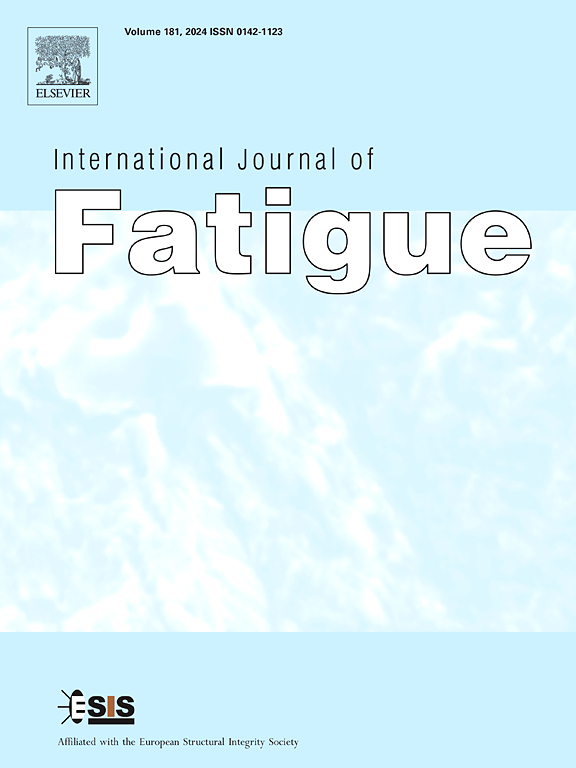Experimental investigation of fatigue crack propagation under non-proportional multiaxial loading
IF 6.8
2区 材料科学
Q1 ENGINEERING, MECHANICAL
引用次数: 0
Abstract
Blisks (bladed disks) are critical components in modern aero-engines that offer significant weight savings compared to conventional blade and disk rotor designs, resulting in improved fuel efficiency. However, due to their integrated design, blisks are susceptible to unique failure modes following foreign object damage (FOD) and crack initiation. Of particular interest is the trajectory of crack propagation from FOD sites, which determines whether failure will occur via a blade-off event or rupture of the blisk.
This work presents an experimental test setup which replicates the key features of non-proportional loading in a blisk. A novel feature of the test rig was the ability to apply loads independently in three axes using a biaxial machine equipped with only two hydraulic servo-actuators. A series of multiaxial fatigue tests were completed on notched cruciform specimens and a wide range of crack trajectories were achieved, validating the design of the test rig.
Crack trajectories produced by non-proportional load paths are not accurately predicted by conventional criteria, such as the maximum tensile stress criterion (MTS), when cracks are subject to high mean mode-II loads. The results of these experiments underscore the complexity of modelling non-proportionally loaded cracks and the acquired crack trajectory data is a useful tool for validating further models.
非比例多轴加载下疲劳裂纹扩展试验研究
布利斯(带叶片的圆盘)是现代航空发动机的关键部件,与传统的叶片和圆盘转子设计相比,它可以显著减轻重量,从而提高燃油效率。然而,由于其整体设计,叶片容易受到外来物损伤(FOD)和裂纹引发的独特破坏模式。特别令人感兴趣的是从FOD位置开始的裂纹扩展轨迹,它决定了是否会通过叶片脱落事件或叶片破裂而发生故障。这项工作提出了一个实验测试装置,它复制了非比例加载在一个圆盘的关键特征。该试验台的一个新特点是能够在三个轴上独立施加载荷,使用仅配备两个液压伺服执行器的双轴机床。在切槽十字形试样上完成了一系列的多轴疲劳试验,获得了大范围的裂纹轨迹,验证了试验台的设计。当裂纹受到高平均ii型载荷时,非比例载荷路径产生的裂纹轨迹不能用常规准则(如最大拉伸应力准则(MTS))准确预测。这些实验结果强调了非比例加载裂纹建模的复杂性,所获得的裂纹轨迹数据是验证进一步模型的有用工具。
本文章由计算机程序翻译,如有差异,请以英文原文为准。
求助全文
约1分钟内获得全文
求助全文
来源期刊

International Journal of Fatigue
工程技术-材料科学:综合
CiteScore
10.70
自引率
21.70%
发文量
619
审稿时长
58 days
期刊介绍:
Typical subjects discussed in International Journal of Fatigue address:
Novel fatigue testing and characterization methods (new kinds of fatigue tests, critical evaluation of existing methods, in situ measurement of fatigue degradation, non-contact field measurements)
Multiaxial fatigue and complex loading effects of materials and structures, exploring state-of-the-art concepts in degradation under cyclic loading
Fatigue in the very high cycle regime, including failure mode transitions from surface to subsurface, effects of surface treatment, processing, and loading conditions
Modeling (including degradation processes and related driving forces, multiscale/multi-resolution methods, computational hierarchical and concurrent methods for coupled component and material responses, novel methods for notch root analysis, fracture mechanics, damage mechanics, crack growth kinetics, life prediction and durability, and prediction of stochastic fatigue behavior reflecting microstructure and service conditions)
Models for early stages of fatigue crack formation and growth that explicitly consider microstructure and relevant materials science aspects
Understanding the influence or manufacturing and processing route on fatigue degradation, and embedding this understanding in more predictive schemes for mitigation and design against fatigue
Prognosis and damage state awareness (including sensors, monitoring, methodology, interactive control, accelerated methods, data interpretation)
Applications of technologies associated with fatigue and their implications for structural integrity and reliability. This includes issues related to design, operation and maintenance, i.e., life cycle engineering
Smart materials and structures that can sense and mitigate fatigue degradation
Fatigue of devices and structures at small scales, including effects of process route and surfaces/interfaces.
 求助内容:
求助内容: 应助结果提醒方式:
应助结果提醒方式:


